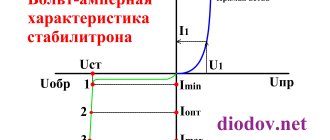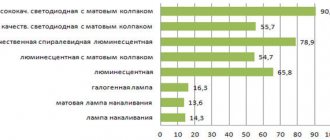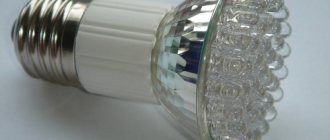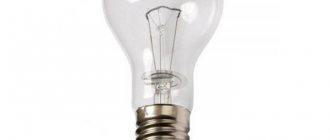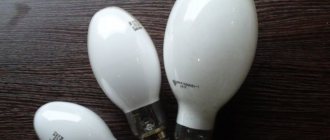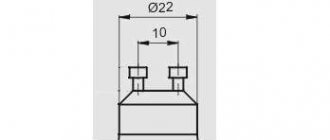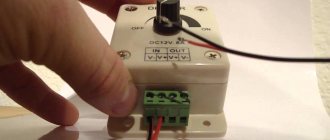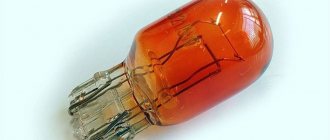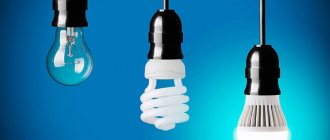The socket is the part of the lamp that connects it to the socket. The products ensure a tight fit of the contacts through which the lamp receives power. All existing cartridges are divided into categories and can only work in tandem with a lamp that has a suitable base.
Therefore, when choosing a lighting device, first of all, pay attention to this parameter. We suggest you understand what types of LED lamp bases there are, what are the specifics of using various devices, and how to choose the appropriate option.
Types of LED lamp bases
One of the criteria by which LED lamps are distinguished is the type of base. All of them can be divided into two volumetric categories - threaded and contact. There are many types within the groups, but among them there are five most popular.
E27 . Used for all standard lamps, and for those where the luminous flux exceeds 1200 Lm, only this type is used. As a rule, E27 lamps operate in alternating current conditions and at a voltage of 220 V.
E14 . Suitable for all types of standard lamps, but with miniature sizes. Lamps with E14, which are also called “minion”, have interesting shapes: candle, mushroom, ball.
GU10 . Has a two-pin connector, swivel mount. They are used for ceiling lighting fixtures in the form of LED lamps with standard size MR16.
The light source placed in the cartridge is held in place by a special lock, which is why they are in demand in places where vibration or other external influences are observed.
GU5/3 . Used in luminaires with lamps powered by LEDs, reflector type MR16 for decorative lighting. They are powered by both 220 and 12V mains.
G13 . Used for tube-shaped lamps T-8 and T-10. They are installed in ceiling panels, which are most often found in office spaces for targeted lighting of work areas.
Before purchasing a new lamp for your lamp, you need to decide on the type of base used in it. There are many types of these elements and not all of them are interchangeable (+)
The first two types are threaded. To connect a product with such a base and a socket, it is screwed in like a simple incandescent lamp.
The remaining three types are contact or pin. These sockets are equipped with pin-shaped terminals located on the edge of the lamp.
Less popular threaded sockets are E10, used in lamps that illuminate the interior of refrigerators, and E42 - for street lamps.
LED luminaires, widely used by designers, are equipped with adapter elements G4, GU4, G9.
Characteristics of threaded holders
Threaded products are the most popular options for plinths. They equip floor lamps, table lamps, lamps, and lanterns. In sconces, small table lamps, hanging lamps and chandeliers, E14 lamps are often used.
LED lamps with such an adapter are gradually replacing incandescent lamps and “housekeepers” from household use.
A light source with an E27 base is a more advanced analogue of a 90 W incandescent lamp. With 11W of power, it produces the same illumination as its more powerful prototype
For high-power luminaires, E40 sockets are most suitable. They are used in industrial workshops and in street lighting.
There are also less popular types of threaded bases:
- E10 , E12 , E17 - small with diameters of 10, 12 and 17 mm, respectively;
- E5 - microscopic with a diameter of 5 mm;
- E26 - medium.
The threaded base is attached to the flask using an adhesive connection. If you need to replace the lamp, you need to do it carefully, otherwise the base may break off. If this does happen, you need to turn off the power to the lighting fixture.
The next thing to do is to carefully unscrew the damaged base using pliers. It is better to avoid such situations when replacing the lamp, it is recommended to rub the thread with graphite.
Classification of LED lamps by design and parameters
To make it easier to understand the topic, we classify LED lamps according to the characteristics most often mentioned by our customers when contacting Ledrus managers.
Form
- corn
- resemble a corn cob with many grains, which are SMD light-emitting diodes. LEDs are located around the entire circumference, emitting light in all directions at 360 degrees. The dispersion angle is 300°. Application – lamps with horizontal bulbs, spot lighting with a shading shade;
- pear
is the most common shape, similar to conventional incandescent lamps. Used in chandeliers with upper socket orientation. With the reverse (lower) orientation, shading of the room is observed;
- candle
– intended mainly for night lights, table lamps and floor lamps. They are characterized by low power, brightness and dispersion angle. Modifications “candle in the wind” and “twisted candle” are available;
- ball
– superior to “pears” in light distribution due to the larger angle of dispersion of the light flux (150-360 degrees);
- mushroom (reflector)
– equipped with a reflector that creates high-density light radiation. Find application in directional light sources;
- spot
- similar to reflectors, differing from them in the flattened end part. Used only in spotlights built into suspended ceilings;
- capsule
- miniature LED lamps designed to replace halogen lamps with a pin base;
- linear (tubes)
- a modern replacement for T8 fluorescent lamps 60/90/120 cm long, made on the basis of LEDs placed in a polycarbonate tube (transparent or matte). Can be installed in traditional fluorescent lamps with minor modifications (removal of starter, inductor, capacitor).
LED type
- SMD
– surface-mount LEDs, manufactured in the form of a single-chip or triple-chip chip mounted on a substrate. The emitted light is focused by a special lens. They differ in size, power consumption, brightness.
- COB diodes
are a new technological solution that consists of mounting any number of LEDs on one board and covering them with a uniform phosphor layer. The board is placed on a ceramic or aluminum substrate. The advantage of COB diodes is a combination of low cost, increased sealing, extended service life, improved uniformity of luminous flux, and better heat dissipation.
- filament threads
- are produced using innovative technology from small unpackaged crystals, sequentially connected into a thread-like structure. Filament threads are installed on glass substrates that evenly distribute the light flux at 360°. The type of phosphor coating applied determines the color temperature of the emitted light. Advantages - increased brightness and energy efficiency of lamps.
Power and brightness
LED lamps are superior to all other analogues in terms of efficiency. They consume less power at the same light brightness as fluorescent, halogen and incandescent lamps. The most popular models are in the power range of 3-25 watts. For the convenience of users, the packaging indicates the correspondence between the power of the LED lamp and incandescent lamp. These data are summarized in the table:
| LED lamp power, W | Fluorescent lamp power, W | Incandescent lamp power, W |
| 1 | 5 | 10 |
| 3 | 15 | 25 |
| 5 | 25 | 40 |
| 6 | 30 | 50 |
| 7 | 35 | 60 |
| 8 | 40 | 65 |
| 9 | 45 | 75 |
| 10 | 50 | 80 |
| 12 | 60 | 100 |
| 15 | 75 | 125 |
| 18 | 90 | 160 |
| 20 | 100 | 175 |
| 23 | 115 | 190 |
| 25 | 120 | 210 |
The brightness of the lamps is characterized by the intensity of the luminous flux. This characteristic is most clearly reflected in the following table:
| LED lamps, W | Fluorescent lamps, W | Incandescent lamps, W | Luminous flux, Lm |
| 3 | — | 20 | 250 |
| 5 | 5 | 40 | 400 |
| 8 | 9 | 60 | 700 |
| 10 | 10 | 75 | 900 |
| 14 | 15 | 100 | 1200 |
| 18 | 20 | 150 | 1800 |
| 25 | 30 | 200 | 2500 |
Luminous flux temperature
- cold – over 5,500K.
Recommended only for work and utility rooms; - neutral – 4,000-5,000K.
Suitable for both office and kitchen, bathroom, pantry; - warm – 2,500-3,500K.
The best option for rooms in an apartment or house.
Control
Dimmable
– specialized ice lamps compatible with electronic brightness control (dimmer). The intensity of the emitted light varies within wide limits by adjusting the operating current. Manufacturers mark this type of lamp with a special icon on the packaging.
Secondary optics
Matte and transparent
– most LED lamps are produced with a matte bulb, which creates better uniformity and uniformity of the light flux. They are optimally suited for open-type luminaires that do not have an additional diffuser element. Transparent ice lamps are usually installed in chandeliers with closed shades, floor lamps, and table lamps with shades.
Standard sizes with radius designation
MR16
– is a design made of a bulb and a multifaceted glass reflector (MR, Multifaceted Reflector) with a radius of 25 mm. Size 16 inches. The cone of emitted light flux has an angle at its apex of 7-60 degrees.
AR111
– lamps of this standard size, intended for recessed cardan lamps, have replaced metal halide lamps. They are installed in bar counters, sometimes in spotlights in the ceiling.
Features GU10, GU5/3, G13 and G23
GU10 . In LED lamps, the GU10 holder is designed non-standardly. At the ends of the contacts it has extensions that firmly hold the lighting element in the socket.
The base of this type is pin. Its contacts are located at a distance of 1 cm. The addition in the form of the letter U indicates the presence of design features of the device (+)
An LED light source with this base, along with the same parameters as its halogen counterpart, has a number of advantages.
It has more intense light, a significantly longer service life, and minimal energy consumption. The main advantage is that it practically does not heat up.
Devices with a GU10 socket are powered from a 110-220 V network. Typically, lamps with such a holder are equipped with a reflector to give the light a certain direction.
A limited number of manufacturers produce low-voltage lighting elements. This is explained by the narrow scope of demand - a purely local lighting system.
Designers use them for interior lighting. They are ideal for splot lighting fixtures.
GU5/3 . The GU5/3 ceramic base contains wires enclosed in a protective sheath. Imported products are operated at a voltage of 12/24 V.
But in Russia, lamps with such a base, adapted to the usual 220 V, are more common. They are connected to the network via terminal blocks, which is more reliable.
The G4 pin base is often present in small spotlights that are used in decorative applications.
G4 LED lamps are often used to replace low-voltage halogen lamps in chandeliers.
The contacts are spaced 5.33mm apart. Fluorescent lamps using GU5/3 are an analogue of multifaceted halogen reflectors and are energy saving.
G13 and G23 . They are installed not only in T8 LED lamps, but also in lighting fixtures such as Armstrong, LSP, and others. The distance between the contacts is 1.3 cm.
G23 are for "U" shaped lamps. A starter is included in its design. Starting is carried out using a choke, usually located in the luminaire body. The power of such devices ranges from 5 to 14 W; they are screwed mainly into table lamps.
conclusions
The presence of such a variety of types of bases is due to the fact that not all lamps are able to operate from the same voltage and in the same electrical circuit. Some lamps can operate from 12-24V, while others from 220-240V. Almost all types of plinths have their own purpose, since their versatility would be ineffective in certain conditions. Thus, LED lamps with an E40 base are only needed for lighting large outdoor areas and are completely unsuitable for home lighting.
When purchasing an LED lamp for your home, you should clearly determine where it will be used in the future and with what models of lamps. Therefore, it is necessary to determine in advance the required lamp power, measure the diameter of the lighting device socket and know the voltage in the electrical network.
Pin bayonet socket
There are special pins on the body of this connecting device. With their help, the base is connected to the cartridge. When developing the product, a specific goal was set - to make the lighting fixture more compact in shape and reduce the time needed to replace light bulbs.
Round side pins (2 pcs.) are located symmetrically on the base. They are secured in the slots of the cartridge intended for this purpose, and then turned ¼ turn for better fixation.
The photo shows an LED light bulb with a bayonet base, marked BA15D. lamp dimensions - 22*60 mm, voltage - 0.5-1 V
One type of pin product is the BA base with asymmetrical side contacts. It is used in cars. The unique design allows the lamp to be inserted into the socket in a special way and focus the luminous flux of the headlights.
In some countries, mainly English-speaking, pin connectors are designated BC, short for Bayonet Cap, in Europe - B22d, in Russia - 2Ш22.
The analogue of the European B15d is the domestic 2Ш15 and in English - SBC, the full name is Small Bayonet Cap. MBC/MBB corresponds to Russian 1Ш9 and European Ba9s.
Some background information
The socket (also holder) is the part with which the light bulb is secured in the socket and receives current. Bases for LED devices are metal, plastic, ceramic . Some models do without this part altogether. The inner part of the holding connector contains filaments, and the outer part contains connecting contacts. To correctly select LED lamp bases, it would be useful to learn a little better about the different types and areas of their application.
Rarely seen holders
Some types of these integral elements of a lighting fixture are quite rare. These also include devices with recessed contacts.
Characteristics of rare types of base
With recessed contact . Belonging to this species is indicated by the presence of the symbol “R” in the marking. They are used in lamps of small dimensions and light weight.
Soffit "S" . There are options for placement on one side of the tubular lamp, or on both. Such sockets are appropriate in lamps used as mirror illumination, in bathrooms, as well as in car showrooms.
The base is soffit with contacts spaced on opposite sides of the lamp. Once upon a time they were used only for stage lighting, hence the name
Fixing "P" . In film projectors, lanterns, and searchlights, the “P” base is used - a fixing one. In terms of design, it resembles a soffit one. The difference is in the presence of an additional scattering platform.
The direction of the required light flux is determined by the prefabricated lens. The design is used for film projectors, spotlights, and flashlights.
Telephone "T" . This type is used in lamps used as backlighting, in remote controls, and in dashboards in cars.
T6.8 socket is used in KM (switch) light bulbs. The number after T indicates that the contact pins are located at a distance of 6.8 mm from each other
In the European Union, KM light bulbs with smaller sizes are used. They are marked according to the base 6 T4.5; T4.6; T5.5.
Glass and cable variations
Among the wide variety of LED lamps, there are also those that are called baseless. This element is there, but it is glass, like the lighting fixture itself.
Their use is narrow-profile. They are most often found in the automotive industry. When the symbol “W” appears at the beginning of the marking, it means it is a lamp with a glass base
On its basis there are current conclusions. Through them, the glass base comes into contact with the cartridge. The numbers present in the markings indicate the thickness of the glass part. They are followed by an “x” and the width of the base.
Cable sockets (K) are also not very common. Their area of application is projector lamps.
Basic specialized bases
Among specialized bases, the R model has become very popular, in which the contacts are recessed into a ceramic or glass case, which promotes heat dissipation. The number in the marking does not indicate the distance between the contacts, but the size in millimeters of the contact itself. The contact group is located on the sides of the bulb, which is available in several sizes, which is reflected in additional markings with numbers. Due to their elongated cylindrical shape, such light bulbs were nicknamed pencils. The most popular model of the R7S base, lamps with which are available in halogen and LED types.
Pin base B has become widespread in low-voltage power supplies, although there are also models for 110/220 V. Most often they can be found as lighting elements in various equipment: cars, motorcycles, ships. This type of plinth is easy to install: it fits into the grooves, presses, and turns slightly. The numbers in the marking indicate the diameter of the base, which increases with increasing lamp power.
How to decipher the marking?
The designation of these products includes several symbols in the form of letters and numbers. The latter talk about the distance between the contacts or the diameter of the connecting part.
The symbols indicating that the base belongs to a certain type are deciphered as follows:
- “E” is the “Edison” base, i.e. threaded;
- "G" - pin;
- “R” - equipped with a recessed contact;
- “P” - focusing base, allowing you to position the lamp in the desired position;
- “B” - bayonet or pin;
- “F” - has one pin;
- a - the pin has the shape of a cylinder;
- b - equipped with a corrugated contact;
- c - indicates the original shape of the pin;
- "S" - soffit.
The number of contacts denotes a specific symbol: one contact - s (single), d - pair (duo), t (tres), q (quatro), p (penta) - three, four and five contacts at the end, respectively.
Specifications are designated by the letters U, V, A. The first is energy-saving lamps, the second is a device with a conical end, the third is car lamps.
When designating a base, use the scheme A00bC, where the first character (A) is the type of base, the second is its dimensions, b is the number of contacts, C is additional data. The last marker may not exist (+)
Pin models with the symbol “X” are present in spotlights. Since the flow has a clear direction, they help place the necessary accents in the room. In lamps for special use, models “Y” and “Z” are used.
LED lamp with E27 connector. Used without additional devices in a 220 V network. Does not work with electronic dimmers
The inscription E14U means that the screw base has a diameter of 14 mm. The lamp itself is energy saving. Marking BA9 indicates 9mm diameter, round pins placed symmetrically.
How to choose the right base?
Based on this criterion, the choice is quite simple: you need to take into account the parameters of the available lamp.
Manufacturers produce a variety of LED lighting devices. They can replace both incandescent and halogen lamps.
For the first group, bases E14, E27, E40 are interchangeable. For the second - GU10, G4, GU5.3. Recessed lamps used for furniture lighting use a GX53 base.
When choosing, you should know some nuances:
- Models with G9 holders are designed for 220 V only.
- If the circuit contains electronic switches and dimmers, you cannot use small lamps with E14 and E27 sockets.
- Since there are many options for pin connector lighting, it can be easy to make mistakes when choosing. For this reason, there is no need to get rid of a burnt-out lamp.
Manufacturers have adapted almost all types of bases to LED light sources. In order for the device to work stably and for a long time, it is necessary to take into account the permissible power for a particular lamp.
So, if the limitation on this parameter is 40 W, then you cannot install an LED lamp rated at 6 W.
Read about additional options for choosing LED lamps in this article.
What do you need to know before purchasing?
Before choosing an LED lamp, you need to remember that the base may differ from the previous lamp. If you are unsure, you should contact either a consultant or make a purchase in a store where an exchange is possible. Dimmers cannot be used for some LED sources. This function is available in special models that connect to dimmable systems; they are marked “dimmable” or have a round icon in the form of increasing or decreasing power. The cost of the lamp is higher, but all requirements for connection and operation are met. It is also worth noting that halogen transformers are not suitable for powering an LED lamp. The specificity of the choice is to choose the right base. You can find out the parameter directly on the packaging in which the lamp is located, or by using the included instructions. If the purchase is made for the first time, and the client replaces the light source with an LED one, it is recommended to contact a consultant. Share the information on social networks if the article helped you understand the issue of choice.
